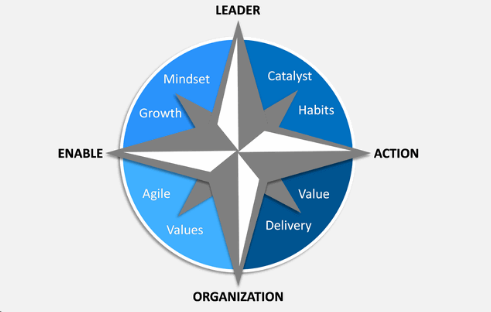What is Gentle Leadership? How to be a gentle leader? Do you know the attributes of gentle leaders? Keep reading to get the answers.
James Kavanaugh once suggested that there are “those too gentle to live among the wolves.” I hope that in the modern organization, this is not still the case. I believe that the “wolves” have had their day, and we need to make way for a new breed of manager—The Gentle Leader. Our organizations today require a specific type of leader who can foster a strong sense of belonging and commitment.
Table of Contents
What is Gentle Leadership?
the creation of environments where all members, regardless of position, are treated with dignity and respect. Leaders who see their role as one that serves the greater good put the interests of others first and serves as a catalyst for these conditions. leaders who can enlist others to support a cause that piques their interests and mobilizes all of their resources. Those in positions of authority think that wealth, status, and titles can only be acquired by helping others.
Men and women genuinely mean it when they use words like forgiveness, sacrifice, and compassion. leaders who, in all their choices and deeds, demonstrate kindness and tolerance. leaders who draw their strength from their unwavering faith in others.
Attributes of Gentle Leaders
extracted from M.S.’s article I came across this list of gentle leadership qualities while researching Rao (see reference below). (The justifications are mine.)
- Character (They support a cause that the rest of us believe to be honorable. They conduct themselves in a reliable, open, and sincere manner.)
- Charisma (They cause others to feel sympathetic understanding, which almost immediately establishes rapport. They don’t only think about themselves; they also think about other people.)
- Conscience (They seem to act in accordance with their own internal moral compass and possess an inner sense of right and wrong.)
- Conviction (They are motivated by tenacity and passion.)
- Courage (This is the capacity to act despite fear, driven by one’s convictions (rather than the absence of fear).
- Communication (They can find ways to express themselves in powerful and personal ways that make listeners feel the gentle leader “gets them” and is speaking directly to their core.)
- Compassion (Along with a strong desire to lessen the pain, suffering, or sorrow they witness, they act with a high degree of sensitivity and empathy toward other people.
- Commitment (No matter how steep the hill in front was, they always had the energy to continue.)
- Consistency (They behave in accordance with a core set of values that others can rely on and that fosters trust.)
- Consideration (Always showing respect for those around them, they consider the impact of their words and deeds.)
- Contribution (They are inclined toward helping others and wanting to change the world. They make substantial footprints.)
I wonder if you recognize many of the qualities listed above in the people in your life who had the biggest influence on you. I know I do.
Why Gentle Leadership is Good for Business
It’s a sign that many things are going well when a company can draw in and keep good employees. People are intelligent; if they give you their time and talents, they expect something in return beyond a regular paycheck.
Certain traits are desired in a business by good people. These can be considered the mission, principles, and culture of your business, in general. Because that is what makes you unique. However, I think that a strong leader is what attracts good people the most. Leaders establish the direction and the atmosphere. They motivate and encourage. If you show me a company with a great leader, I’ll show you a motivated team producing excellent work and developing together.
Leadership is Not a Power Trip
Of course, there are a variety of schools of thought regarding what constitutes effective leadership. But in my opinion, power-based leadership is not a good form of it. It might get things done, but if you want to draw in and keep good employees, you’d better find another approach. Keep in mind that momentum is difficult to develop on a team that is constantly changing. Moving forward and backward in two steps.
Furthermore, this is frequently the case.
Employee Happiness at the Heart of Success
I have over thirty years of experience managing profitable businesses. They have over 100 employees working in events, hospitality, and retail. Many of these individuals have worked for us for years. They’ve developed along with us. Make no mistake: the level of satisfaction of your workforce and the shared environment you foster determine the quality of what you do.
I employ a strategy that I’ve developed and refined over the years to manage my teams. It is known as “Gentle Leadership.” It’s dynamic and constantly changing, just like anything involving people. It is also based on sincere characteristics.
Simply put, I’ve discovered that things get done if I’m kind to people, treat them well, and do so consistently and with respect. And a good job is done on them. And they keep getting done well. by contented and active individuals. Who knew?
That sounds simple. It’s not; at times, gentle leadership calls for firmness. But what really makes a difference is the attributes you bring to being tough. You can be both firm and impartial.
Gentle Techniques for Positive Growth
My leadership style is based on a number of techniques that are intended to help you lead a little more gently, such as taking the time to simply chat with your team, the power of praise, and setting an example. You can believe that I’m not perfect. Along the way, I’ve done things wrong. However, every step has been instrumental in getting me and my teams where we are now.
We are winning, I assure you.

5 Ways to Incorporate Gentleness into Your Leadership
1. Leaders who are gentle exercise self-control when addressing challenging issues.
The best time for the person in need is when gentleness decides to tackle challenging issues. Wait. Remain in control. Strength in control is gentleness.
2. Gentle leaders speak the truth with love and respect.
In love, gentleness speaks the truth. Gentleness preserves respect and kindness when bringing up a sensitive topic. When talking about those delicate subjects, you can still be honest. But be gentle, and treat people with love and respect. Respect is moved by gentleness.
3. In a crisis, gentle leaders are trustworthy and composed.
In a crisis, gentleness maintains its composure while being vigilant for potential threats. In a crisis, make an effort to maintain a calm tone and steady pace. When dealing with life’s hurricanes and tsunamis, you must be trustworthy. When faced with challenges, keep your composure and remain in the game. However, try not to overreact. A positive and dependable response comes from gentleness.
4. Leaders who are gentle can be trusted to cover and safeguard vulnerable areas.
While addressing the hurt that needs to be healed, gentleness guards weak spots. Sometimes a wound needs time to heal and to be explored in a safe environment. Do people trust you to treat hurts gently? Can someone rely on you not to prod or poke them or reveal a hurt in a hostile environment? To soothe and guard vulnerable areas, a prayer is a wonderful tool. Gentleness is reliable.
5. Asking questions and displaying grace are traits of gentle leaders.
Although gentleness takes its time to weigh all the evidence, it is quick to ask for and grant forgiveness. Investigate Jesus’ life. He frequently asked questions in response to challenges. Grace was given instead of judgment. Try out your forgiveness-extending and forgiveness-asking skills. Conflict resolution is done with grace and gentleness.
Read more: Leadership Principles USMC: How to Be a Marine Leader – Connect to Work
How Hard is It to Change Your Leadership Style?
After learning the ins and outs of the aforementioned strategies, what if you decide that you want to make some changes? Perhaps you consider yourself to be a transactional leader and wish to be more transformational, or you believe your current approach could benefit from more servant leadership.
The good news is that your personal leadership style is something you can change. “Your leadership style isn’t an annual membership,” says Crawford, you can change your strategy at any time and it is actually quite simple in theory (though a little is more challenging in practice). The key is to swap out ineffective habits for new ones that are more in line with the style you’d like to align with, and “stay committed to practicing your new leadership style and technique.”
For example, if you tend to be autocratic and want to incorporate some more democratic practices, try some things that force you to relinquish some power like:
- obtaining a second opinion regarding a decision you are considering.
- establishing regular team brainstorming meetings.
- enlisting a teammate to help you with a project that you would have otherwise handled on your own
Padua advises that you start by considering a leader or mentor you looked up to if you’re having trouble even figuring out how you can be more effective or what the best leadership style is for you. “What were their characteristics?” she asks. “How did they behave and what did they say? Why did it affect you?”
You can identify some characteristics from that exercise that you want to incorporate into your personal style.
Here’s the thing: There’s no such thing as a “perfect” leadership style because leadership isn’t one size fits all. Each of these methods has advantages and disadvantages, and some of them will be more useful in particular circumstances.
That very idea has paved the way for one final style: situational leadership. It is very adaptable and recommends that leaders change their strategy depending on the situation they are in.
No matter how you currently perceive your style to fit, you can probably improve it with a few tweaks. It takes some trial and error to get it right when learning leadership, just like with anything else.
“Don’t be afraid to make mistakes,” concludes Crawford. “It may take a few tries with various learning styles to get things to work in some cases, but that’s how we all learn. Be easy on yourself.”
Read more: 40 Best Leadership Podcasts Of 2022: To Be A Better Leader – Connect to Work
FAQs
What Are the 4 Basic Leadership Styles?
Types of Leadership Styles
- Autocratic.
- Democratic.
- Laissez-faire.
- Transformational.
What Are the 7 Levels of Leadership?
- Level 1: Self-Leader. Self-mastery is the first step in leadership. …
- Level 2: Team leader.
- Level3: Leader of Leaders..
- Level 4: Organizational leader.
- Level 5: A famous person
- Level 6: Sovereign.
- Level 7: Diety.
Final Words
“Can someone develop into a Gentle Leader?” you might ask. Yes, but it’s not simple, and it’s definitely not for the weak of the heart. It might be the most difficult transition you face in your leadership career. It calls for extraordinary bravery, boldness, and daring: the bravery to set aside your desire for praise and recognition, the boldness to ask every member of the organization to take a seat at the organization’s steering wheel, and the daring to commit to a high-performance agenda based solely on passion and service to others. But the effort is worthwhile because of the benefits.





